The AMD Ryzen 9 3950X Review: 16 Cores on 7nm with PCIe 4.0
by Dr. Ian Cutress on November 14, 2019 9:00 AM ESTGaming: Far Cry 5
The latest title in Ubisoft's Far Cry series lands us right into the unwelcoming arms of an armed militant cult in Montana, one of the many middles-of-nowhere in the United States. With a charismatic and enigmatic adversary, gorgeous landscapes of the northwestern American flavor, and lots of violence, it is classic Far Cry fare. Graphically intensive in an open-world environment, the game mixes in action and exploration.
Far Cry 5 does support Vega-centric features with Rapid Packed Math and Shader Intrinsics. Far Cry 5 also supports HDR (HDR10, scRGB, and FreeSync 2). We use the in-game benchmark for our data, and report the average/minimum frame rates.
All of our benchmark results can also be found in our benchmark engine, Bench.
| AnandTech | IGP | Low | Medium | High |
| Average FPS |  |
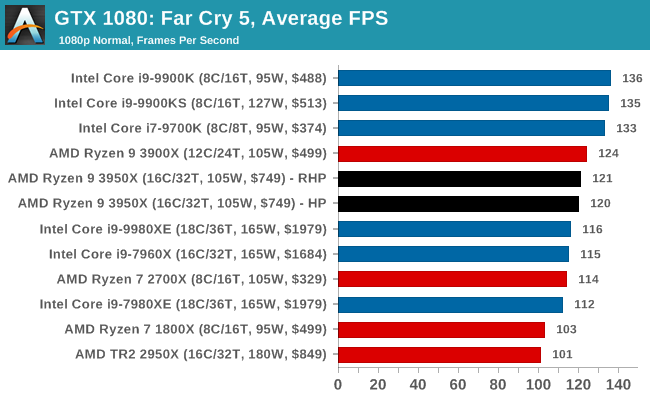 |
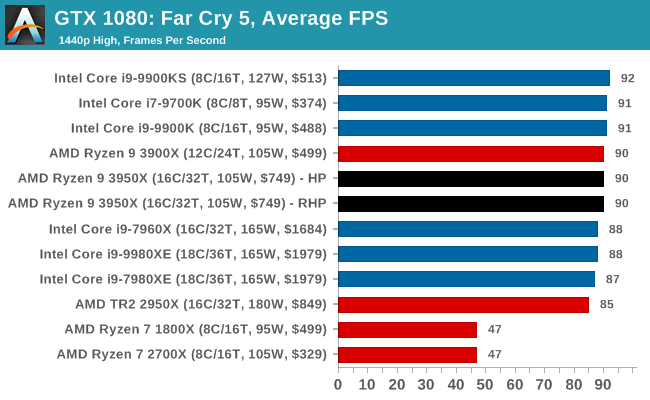 |
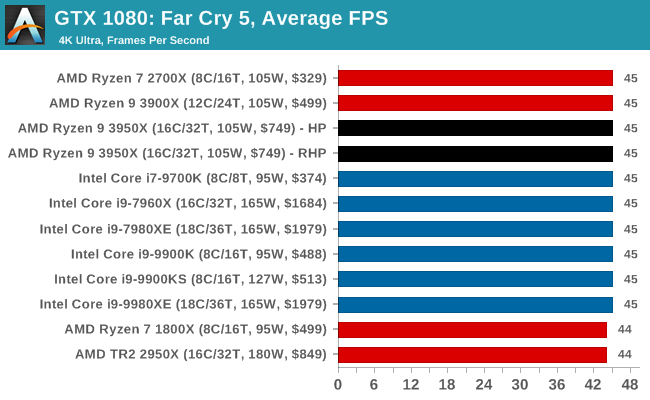 |
| 95th Percentile | 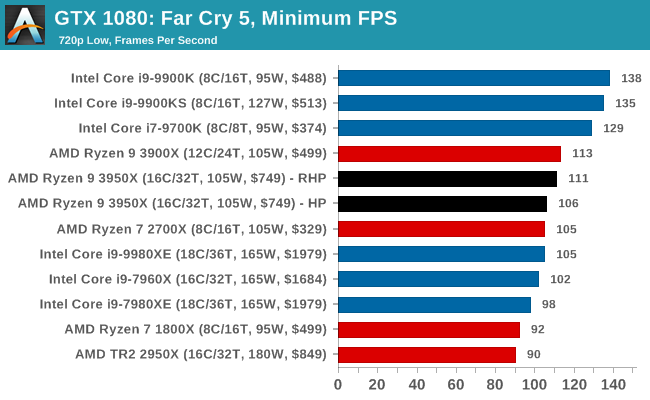 |
 |
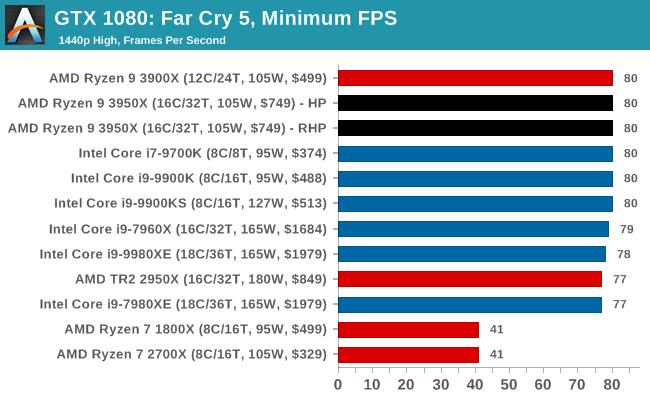 |
 |












206 Comments
View All Comments
drunkenmaster - Thursday, November 14, 2019 - link
That's not really how it works. 10nm for Intel is struggling for clock speed and yields but more importantly the architecture remains fairly close to the same overall. What architecture gains they made they appear to be losing in clock speed.The only really big advantage AMD has from 7nm TSMC, aside from also lower clocks, is die size. They can fit 16 cores into a die size that Intel can, but can't easily. Frankly the only direct benefit Intel will get from 10nm is the fact that a similar 16 core chip would hopefully use the same power as AMDs, though with the way their 10nm is working due to poor yields and lacking clock speeds they would likely up the voltage to push clock speeds as high as possible and well, there is a reason their 10/12 core stuff isn't coming out on 10nm any time soon.
AMD gained performance on architecture but they were already close to this competitive with their 8 core 14nm chip (a worse than Intel 14nm node). As with what Intel would gain, AMD gained in performance/watt and die size, the actual competitiveness of their chips is purely due to being a competitive architecture. Intel won't magically destroy them, they'll be in the same ballpark.
This is the thing people have been kind of weird about, a year ago Zen 1 wasn't far behind Intel on a significantly worse '14nm' node that was more like a lets say 18nm node and Intel had the best 14nm node by a mile. While AMD have a headstart on better nodes when Intel gets to 10nm it's only in the same ballpark as TSMC 7nm. Even when Intel finally make the leap they are only gaining parity with TSMC, not an advantage and their architectural advantage is not really there. With Icelake the only 'win' is AVX512, which is basically unused for the home market.
10nm won't enable Intel to destroy anyone, if their 10nm started working well it would enable them to drop to similar power usage as AMD and offer similar core counts in the same die sizes, the architectures are close enough that the chips would be pretty damn close in overall performance.
Though that's assuming Intel managed a 16 core with a ringbus which is one of the major reasons for it's competitiveness in areas like gaming. If they have to go to a mesh for 16 core then they lose that advantage.
Spunjji - Thursday, November 14, 2019 - link
Solid assessment. Thanks for the post :)lobz - Thursday, November 14, 2019 - link
My dear friend, intel's 10nm chips will not be superior in performance, because they can't hit either the same core count or the frequency needed to let the high IPC matter. Also, by the time intel's 7nm comes out, AMD will have a better than the current process and an even faster architecture. We're speaking at least 2 years from now. Destroy AMD's chips? Good luck.drothgery - Thursday, November 14, 2019 - link
Except at the highest core counts (on the desktop, HEDT, and server), Intel has much more of a pricing problem with Ryzen than a performance problem.Phynaz - Thursday, November 14, 2019 - link
I would say AMD has the pricing problem, as Intel sets their own price, where AMD has to react to intel.Death666Angel - Friday, November 15, 2019 - link
Intel: "We just decided to drop the 10xxx HEDT pricing by 50% or so. No reaction to any of our competitors. Totally our own decision. Move along, nothing to see here." I get that.Qasar - Saturday, November 16, 2019 - link
intel sets its own price, maybe before, but not now. as Death666Angel said, intel didn't drop the price of its 10xx series cpus cause they were being nice, it was because they can't charge that much any more.John_M - Monday, November 25, 2019 - link
That's such a dumb argument. If course they'll be competitive on price if they are priced to compete! You can say that about anything. The sentence reduces to nothing.AIV - Thursday, November 14, 2019 - link
Market pricing for intel HEDT processors have already halved. eg. i9-9980XE is now available for ~1050EUR. See https://geizhals.eu/intel-core-i9-9980xe-extreme-e... .Jorgp2 - Thursday, November 14, 2019 - link
That's retailers lowering prices to clear stock, has nothing to do with Intel